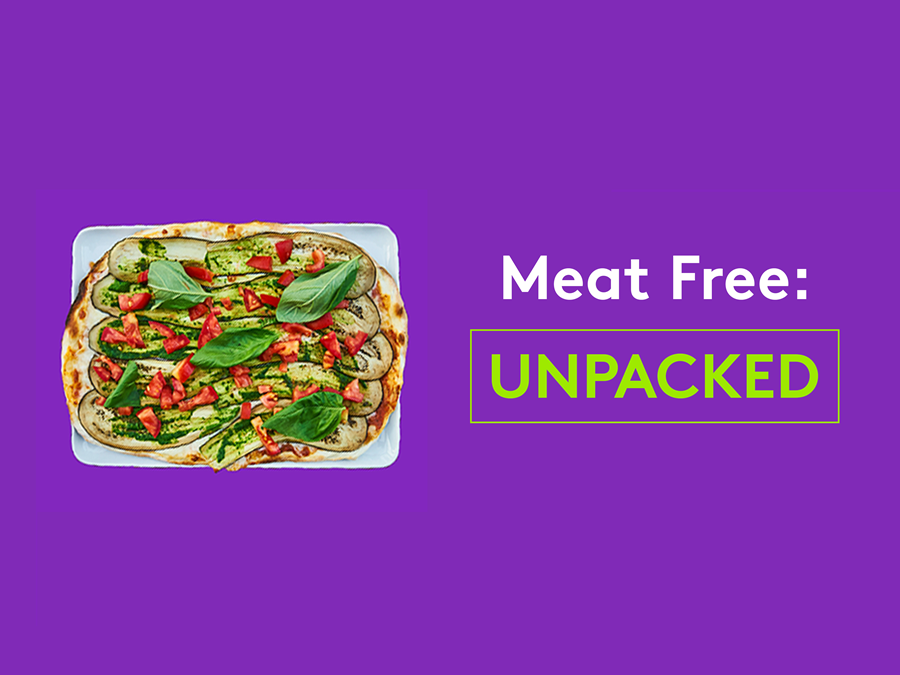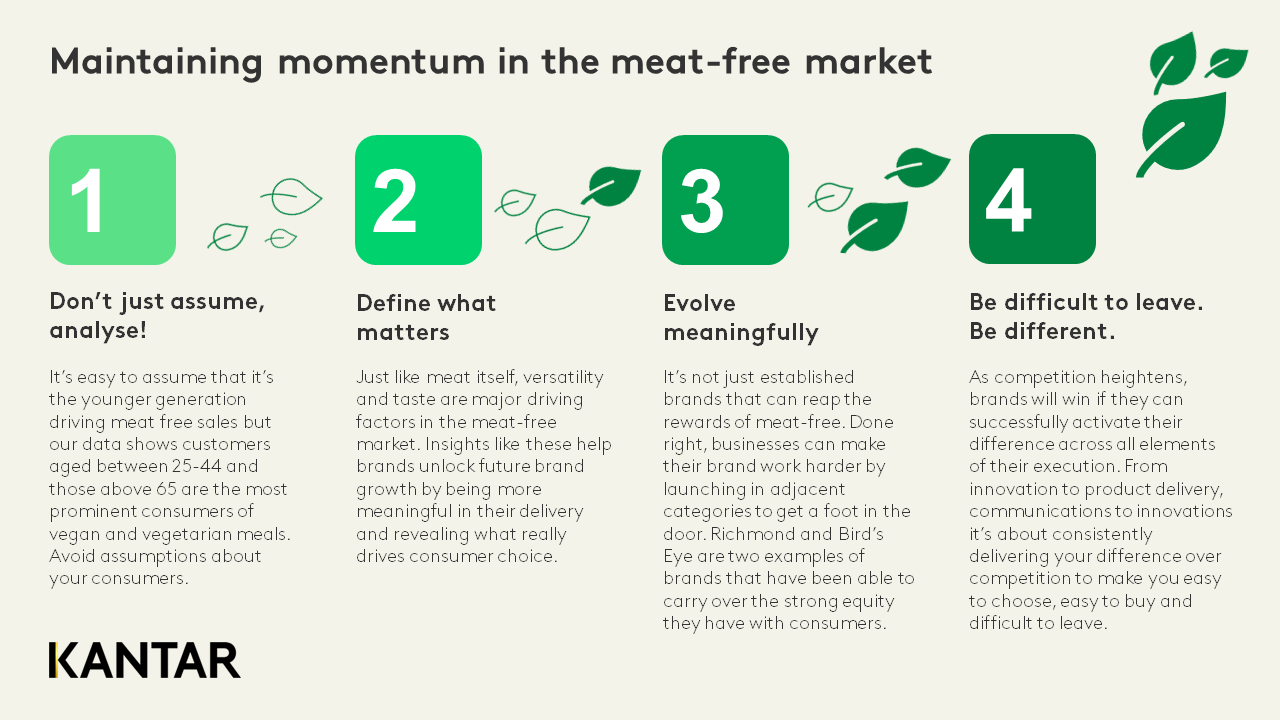As new year’s resolutions got underway, the battle for the healthy pound was in full swing. The meat-free market in particular has been one of the bigger success stories of the supermarket aisles in recent years, but if brands want to maintain that growth they’re going to need to sharpen their marketing strategies.
With the sector maturing and competition becoming fiercer, more sophisticated understanding of who meat-free customers are and what drives them to buy will be key to helping brands flourish. There are also huge opportunities for businesses not already in the market to establish a foothold.
In this article, part of our #BrandStrategyUnpacked series, let’s take a look at how brands can put together a winning approach in 2023.
Data is king
The #meatfree sector has changed dramatically over the past decade and brands need to have their finger on the pulse of how their target market is evolving. It’s easy to assume that it’s the younger generation pushing up sales, but our data shows this isn’t quite true. In fact people aged between 25-44 and those above 65 are the most prominent consumers of #vegan and #vegetarian meals. Perhaps surprisingly, consumers aged 24 and under are most likely to have meat-based meals. As budgets get tighter this year and habits change, we could see yet more flux in the category.
Category managers will be keeping a watchful eye on sales data, but it’s crucial to share this insight across organisations to avoid misconceptions taking hold – from product development and marketing teams through to external partners at creative and media buying agencies. It can be tempting especially to tilt advertising and marketing campaigns towards younger consumers to lend excitement and a 'cool’ factor to a brand, but with data showing that young adults aren’t the biggest consumers of meat-free products, money could be better spent. By truly understanding ‘who’ your target audiences are from the outset, you can meaningfully deliver products, innovations and marketing to driver preference and loyalty as you meet more needs, more often.
Meat free = compromise free
The second common myth to bust in the category is why people choose meat-free. Our Sustainability Sector Index 2022 showed that customers don’t want to compromise when it comes to being meat-free, in fact their decisions are fuelled by products that can not only guarantee no compromises but that also deliver even better experiences.
Just like meat itself, versatility and taste are major driving factors in the meat-free market. This is best illustrated with the example of market leader, Quorn. Its position in the meat-free market is not driven mainly by consumers’ concerns around climate change, animal welfare or being healthier, although those factors matter. It is quite simply, the taste and versatility of its products. Our data shows these associations of #Quorn in people’s minds drive consumer demand for its products to nearly double the volume of its nearest competitor, even though the two were founded within a decade of each other and both offer a wide range of products.
Insights like these help brands unlock future brand growth by being more meaningful in their delivery, revealing what really drives consumer choice by understanding the needs behind a decision while also mapping out where competitors stand to ensure brands can maintain their difference.
Extending the brand
It’s not just established meat-free brands who can reap the rewards. Done right, businesses can make their brand work harder by launching in adjacent categories to get a foot in the door. Richmond’s strong reputation forged in the meat market, for example, has helped it launch the meat-free sausage, leveraging brand associations to promise the taste and quality of the original brand, while Bird’s Eye has leveraged its connection with the humble petit pois to roll out its extensive pea-protein based “Green Cuisine”.
#Richmond and #BirdsEye have been able to carry over the strong equity they have with consumers. This is important and whether new entrants or more established in the category, meat-free brands need to do all they can to protect their position in customers’ minds. This is ultimately what sets them apart, secures their products’ position in shoppers’ baskets and allows them to set prices and maintain profitability.
The stage is set for change
Whether you call it veganism, vegetarianism, conscious consumption or meat-free, the market for meat alternatives is continuing to mature. Competition is heightening, meaning that current and future brands need to focus on both human and brand centric insights to develop a resilient position, highlight your difference and drive selection. There can be no room for complacency. Investing in analysing what drives a brand’s success and sharing these insights across every division of the business is imperative to ensure meaningful evolution and execution. Finding the frictions and fuels that drive consumer choice and applying your brands difference to the conversation will help your brand drive the meaningful difference that helps you win in #Veganuary and beyond.
Find and follow #BrandStrategyUnpacked on LinkedIn
With the sector maturing and competition becoming fiercer, more sophisticated understanding of who meat-free customers are and what drives them to buy will be key to helping brands flourish. There are also huge opportunities for businesses not already in the market to establish a foothold.
In this article, part of our #BrandStrategyUnpacked series, let’s take a look at how brands can put together a winning approach in 2023.
Data is king
The #meatfree sector has changed dramatically over the past decade and brands need to have their finger on the pulse of how their target market is evolving. It’s easy to assume that it’s the younger generation pushing up sales, but our data shows this isn’t quite true. In fact people aged between 25-44 and those above 65 are the most prominent consumers of #vegan and #vegetarian meals. Perhaps surprisingly, consumers aged 24 and under are most likely to have meat-based meals. As budgets get tighter this year and habits change, we could see yet more flux in the category.
Category managers will be keeping a watchful eye on sales data, but it’s crucial to share this insight across organisations to avoid misconceptions taking hold – from product development and marketing teams through to external partners at creative and media buying agencies. It can be tempting especially to tilt advertising and marketing campaigns towards younger consumers to lend excitement and a 'cool’ factor to a brand, but with data showing that young adults aren’t the biggest consumers of meat-free products, money could be better spent. By truly understanding ‘who’ your target audiences are from the outset, you can meaningfully deliver products, innovations and marketing to driver preference and loyalty as you meet more needs, more often.
Meat free = compromise free
The second common myth to bust in the category is why people choose meat-free. Our Sustainability Sector Index 2022 showed that customers don’t want to compromise when it comes to being meat-free, in fact their decisions are fuelled by products that can not only guarantee no compromises but that also deliver even better experiences.
Just like meat itself, versatility and taste are major driving factors in the meat-free market. This is best illustrated with the example of market leader, Quorn. Its position in the meat-free market is not driven mainly by consumers’ concerns around climate change, animal welfare or being healthier, although those factors matter. It is quite simply, the taste and versatility of its products. Our data shows these associations of #Quorn in people’s minds drive consumer demand for its products to nearly double the volume of its nearest competitor, even though the two were founded within a decade of each other and both offer a wide range of products.
Insights like these help brands unlock future brand growth by being more meaningful in their delivery, revealing what really drives consumer choice by understanding the needs behind a decision while also mapping out where competitors stand to ensure brands can maintain their difference.
Extending the brand
It’s not just established meat-free brands who can reap the rewards. Done right, businesses can make their brand work harder by launching in adjacent categories to get a foot in the door. Richmond’s strong reputation forged in the meat market, for example, has helped it launch the meat-free sausage, leveraging brand associations to promise the taste and quality of the original brand, while Bird’s Eye has leveraged its connection with the humble petit pois to roll out its extensive pea-protein based “Green Cuisine”.
#Richmond and #BirdsEye have been able to carry over the strong equity they have with consumers. This is important and whether new entrants or more established in the category, meat-free brands need to do all they can to protect their position in customers’ minds. This is ultimately what sets them apart, secures their products’ position in shoppers’ baskets and allows them to set prices and maintain profitability.
The stage is set for change
Whether you call it veganism, vegetarianism, conscious consumption or meat-free, the market for meat alternatives is continuing to mature. Competition is heightening, meaning that current and future brands need to focus on both human and brand centric insights to develop a resilient position, highlight your difference and drive selection. There can be no room for complacency. Investing in analysing what drives a brand’s success and sharing these insights across every division of the business is imperative to ensure meaningful evolution and execution. Finding the frictions and fuels that drive consumer choice and applying your brands difference to the conversation will help your brand drive the meaningful difference that helps you win in #Veganuary and beyond.
Find and follow #BrandStrategyUnpacked on LinkedIn


